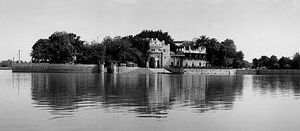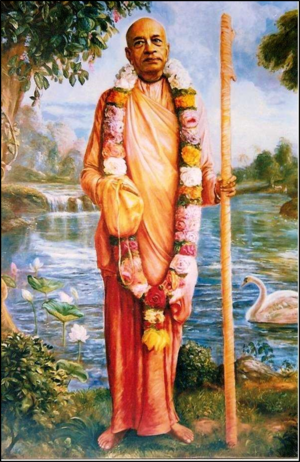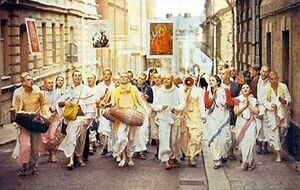Talk:Bhakti Prachāra: Spreads the message of bhakti despite great loss
By Vishal Agarwal
Bhakti Yogī-s are great missionaries of Hindu Dharm and have taken their faith to non-Hindus in and out of the Indian subcontinent, often at great personal risk and cost. In the Rāmāyaṇa, Hanuman obeys Rama’s command to not accompany him to Vaikunṭha and instead stay on the earth –
Hanuman said- As long as Your purifying story circulates through the world, so long I will reside here, obeying your command. Rāmāyaṇa 7.108.35
It is believed that whenever the Ramayana is narrated publicly, Hanuman is present incognito. In the same text, Luv and Kush, the twin sons of Rama, sing His biography in Ayodhya to the masses. Perhaps after their names, public bards are referred to as ‘Kushīluv’ in the Hindu tradition.
Indo-Greeks, Huns, Shakas, etc. became worshippers of Shaivite and Vaishnavite Hindu Dharm in ancient times. Some of the first images and inscriptions in honor of Hindu Deities that have been found during archaeological investigations were sponsored by non-Indians who adopted various Hindu traditions. Around 1000 CE and thereafter, the Nātha Yogī-s traveled even into Afghanistan to spread their doctrines and practices during Islamic rule. Even today, institutions founded by Rattan Nāth, Chaurangī Nāth, Gorakhnāth, and others exist in Pakistan and Afghanistan though all Hindus have been expelled from the region.
The Rāmānandi-s started fanning out in 1400 CE or so and set up several Vaishnavite institutions, even in the Indus Valley. Closely following them, the Sikh Gurus themselves traveled far and wide and set up branches of their following till Kabul to spread their Bhakti doctrines. Today, Sikhism is considered a religion separate from Hindu Dharm but that was not the case in the times of the Gurus. The heretical Sikhs, the Udāsī-s, who followed the teachings of Baba Shrichandra (the eldest son of Guru Nanak) kept the torch of Dharm alive in what is today Pakistan and eastern Afghanistan.
The followers of Chaitanya Mahāprabhu, who revived worship at Vrindāvana, spread Vaishnavism among rural masses in Bengal. In recent times, the Hare Krishnas, who follow his teachings, have spread this branch of Hindu Dharm all over the world. Chaitanya himself converted Muslims to Vaishnavism. In a specific case, he brought to the fold of Dharm a group of around 10 Muslim Pathans who had come to persecute him. Their descendants came to be known as Pathania Vaishnava-s. Some followers of Chaitanya took Vaishnavism to the valley of Manipur in the late 18th century, and this remains the predominant faith of the Metei people of the region even today. Shankar Dev of Assam and his followers spread Vaishnavism among the tribes of the Brahmaputra valley in northeast India, and also among several hill tribes. Likewise, Vallabhāchārya’s followers spread Krishna Bhakti in the greater Indus valley. Stories of two saintly followers from this tradition are narrated below.
In the Gita, Krishna exhorts Arjuna to spread His message to anyone willing to hear it with faith-
He who shall teach this supreme secret to my Bhaktas, showing the highest devotion to Me, shall doubtless come to Me. Gita 18.68 And no one among humans shall do more pleasing service to Me than he and no other on earth shall be dearer to Me. Gita 18.69
Goswāmī Lāl Jī, the Orphan who was adopted by Krishna
Goswāmī Lāl Jī was born to Brahmin parents in Sehwan in Sindh (Pakistan) in the year 1551 CE. His childhood name was Tulsidās. At a very young age, his parents passed away. He traveled for two years till he reached Vrindavan, the town where Krishna had spent his childhood. Krishna appeared to him in a dream and asked him to go to Mathura where he was born. At Mathurā, Shri Vitthal Nāth, the second son of Vallabhāchārya adopted him. Tulsidas was assigned the duty of carrying water to Shri Nāthjī Mandir every day. Out of love, Vitthal Nāth referred to his adopted son as ‘Lāl’ (meaning ‘dear son’) and that is how he was called later on.
After a few years, Shri Vitthal Nāth gave seven Krishna mūrtis to his family members and asked them to construct seven Mandirs to worship Krishna. He gave the eighth mūrti (called ‘Gopināth jī’) to Lāl jī and asked him to spread the worship of Krishna in northwest India (today the country of Pakistan). He taught him the correct way of worshipping the mūrti and declared that Lāl jī was now ‘Goswāmī Lāl Jī, eighth of the eight leaders of the tradition of Vallabhāchārya. For over two years, Lāl jī took the mūrti to various towns of northern Pakistan till he was tired. But he felt that Krishna was not pleased with any of those locations. Finally, he prayed to Krishna and said, “I have been worshipping you and carrying you for two years. But now I am tired. Please settle down in one place that you like, and I will construct a Mandir for you at that place.” Krishna appeared to him in a dream and said, “If you are tired, place me down and I will follow you. You can be sure that I am following you from the sound of my anklets.”
After a long journey, they reached the broad river Indus. Goswāmī Lāl Jī crossed the Indus with the mūrti on a boat and landed on the west shore. He placed the mūrti on the ground but after some time, he could not hear the anklets. Therefore, Goswāmī Lāl Jī assumed that Krishna wanted to stay in that location. The place was called Dera Ghazi Khan and was ruled by a Muslim king of the Baloch tribe. He reached a fruit orchard owned by a Hindu merchant and placed the mūrti under a tree. Worship of the mūrti started and people started showing up in large numbers.
The merchant was upset that Goswāmī Lāl Jī had encroached upon his private property and asked him to leave the place and take his mūrti with him. But when Goswāmī Lāl Jī followed his orders, the merchant suddenly experienced a sharp pain in his stomach. No physician was able to cure the pain. Finally, the merchant went and apologized to Krishna and Goswāmī Lāl Jī and asked them to return to his orchard. As soon as they returned to that tree, the merchant’s pain disappeared. When the local Muslim ruler, who was childless, heard of the miracle, he too came to Goswāmī Lāl Jī and asked him to pray to Krishna, so that the ruler could become a father. After a few months, a baby boy was born to the ruler.
The Hindu merchant and the Baloch Muslim ruler donated a large amount of money which was used by Goswāmī Lāl Jī to construct a beautiful Mandir in Dera Ghazi Khan in 1586 CE. Goswāmī Lāl Jī settled down in Dera Ghazi Khan. His children and grandchildren were born there. One of the famous grandsons of Goswāmī Lāl Jī was Sant Kewal Rām. In 1947, when the country of Pakistan was carved out of India, all the Hindus of Pakistan were expelled. The Hindus of Dera Ghazi Khan brought the mūrti from their temple and constructed a new temple for it in Vrindavan.
Sati Kewal Rām – Spreading Vaishnavism in Trans Indus Areas and Southern Punjab
Sant Kewal Rām was born in 1617 CE in Dera Ghazi Khan. He was a very religious child. When his father Goswāmī Mathurā Nāth passed away, Sant Kewal Rām decided to roam all over Pakistan and Afghanistan to stop the conversion of Hindus to Islam. The ruler of Afghanistan was furious and ordered his soldiers to arrest Sant Kewal Rām. When the soldiers came to arrest the Sant, he was sitting on a wall. He asked them to return to their King’s palace and that he will follow them. As they started on horseback, Sant Kewal Rām showed a miracle. The wall on which he was sitting started following the horses and soon overtook them! When the ruler heard of this miracle, he was terrified and gave a big donation to the Sant, who passed it on to the Mandir in Dera Ghazi Khan. The forcible conversion of Hindus was stopped in the area, thanks to the miracle of the Sant.
After a few years, Sant Kewal Rām decided to settle down a little north of Dera Ghazi Khan. This new home was in an area called Dera Ismail Khan and was also located west of the river Indus. There, he erected a platform on which he sat and regularly gave talks on Hindu Dharm (and specifically the teachings of Vallabhāchārya). Many Muslim saints lived in that area and they opposed Sant Kewal Rām’s arrival. One day, a Muslim saint spread a cloth on the Indus river and floated on it as if the cloth were a boat. He challenged Sant Kewal Rām to repeat the miracle. The Sant bested the Muslim saint by throwing a rock into the Indus and then floating on it as if the rock were a boat. Another Muslim saint once threw a snake at him. The Sant converted the snake into a stone.
One day, Sant Kewal Rām was traveling on the Indus River, using a piece of cloth as a boat. A Muslim saint was watching him with his head out of a window in his home. The Muslim saint performed some magic so that the Sant would drown. When the Sant realized that he was drowning, he performed some countermagic so that the Muslim saint grew horns and his chin enlarged so that his face got stuck in the window. The Sant then forgave the Muslim saint and asked him not to ever misuse his magical powers.
Local Muslims still visit the platform of Sant Kewal Rām in Dera Ismail Khan and light a lamp in his honor. The platform is now taken care of by Muslim caretakers. A photograph of this platform is shown
Swami Bankhandi Maharaj (1763 – 1863 CE)
Originally from Nepal, Swami Bankhandi became a follower of the Udāsī community of Sadhus at a place called Kurukshetra in northern India. This community of Sadhus was founded by Shrichand, the eldest son of Guru Nanak. The Udāsīs traveled all over India, Pakistan, Nepal, and Afghanistan to spread the message of Hindu Dharm and the Sikh Gurus.
When Bankhandi Maharaj arrived in the Sindh region (today in Pakistan) in 1823, the area had been under Muslim rule for 1100 years. Hardly any old Hindu temple had survived. There were practically no scholars who had studied the important Hindu scriptures. Hindus were not allowed to celebrate their festivals, own land, ride horses, or even wear good clothing. They were frequently harassed by the rulers and did not dare to worship mūrtis. Instead, most Hindus had started worshipping Muslim holy men at their graves. Swami Bankhandi decided that he would spend the rest of his life teaching true Hindu Dharm to the Hindus of Sindh, who still formed 20% of the population of the region.
In the Indus river which flowed in that area, there were several islands on which no one lived. Bankhandi chose a small island close to the city of Sukkur. This island was covered with plants and thorny bushes. Gradually, Bankhandi cleared the island and started installing one mūrti after another. He lived there for 40 years, meditating, worshipping, and working hard to create small Mandirs over these mūrtis.
Bankhandi passed away, his students approached rich Hindus of the area. With the donations received, they gradually constructed beautiful Mandirs, rest houses, and other structures for Hindu visitors one after the other. The result was that soon, Hindus started coming to the island in thousands, especially on festival days. The efforts of Swami Bankhandi, and his meditation and courage created a new holy place of worship for the Hindus, who had been prevented from practicing our Dharm freely for over 1000 years.
In 1947, Sindh became a part of Pakistan and most Hindus fled to India. But even today, there are 2.5 million Hindus in Sindh. On festival days, more than 20,000 Hindus come to celebrate, taking boats from the banks of the Indus River. Many Hindus from India too go to worship at the Mandirs on the island and offer their respect to Swami Bankhandi Maharaj, who had spent many years of his life creating a center of worship for the Hindus of Sindh.
Bhaktivedānta Swami Prabhupāda (1896 – 1977 CE)
In recent times, the one person who has done the most in taking the message of Chaitanya Mahāprabhu and Hindu Dharm in general to various parts of the world is Bhaktivedānta Swami Prabhupāda. He was born in 1896 to a very religious father, who taught him the art of singing bhajans, and leading satsangs and also introduced him to his Guru Bhaktisiddhānta Saraswati Thakur. Swami Prabhupāda’s childhood name was Abhay Charan De. His Guru was very impressed with Abhay’s dedication to Krishna, and skills in the English language and often told him, “If you ever have money, use it for publishing books in English for spreading the message of Chaitanya Mahāprabhu all over the world.”
However, Abhay married and lived with his wife and children till the age of 54. He ran a business and worked several jobs for over 30 years to support his family. Whenever he got time, he would invite other devotees of Krishna for spiritual discussions and bhajans. But his wife never participated and preferred to sip tea in another room. Under her influence, his children too did not get very interested in their father’s activities. One day, at the age of 54, Abhay returned home to find that his wife had sold his holy book, a copy of Shrimad Bhāgvatam, to buy herself a packet of tea biscuits. He was very disappointed and thought, “I have tried for 32 years to make her a Bhakta of Krishna. I have fulfilled my duties as a father and a husband. But now, I will spend the rest of my life for the sake of Krishna.”
He left his home, and in 1959, he became a Sannyāsī and was given a new name – Abhay Charan Bhaktivedānta Swami Prabhupāda. He had no place to live, and no source of income. He begged for food and depended on the generosity of others to live in Delhi and Vrindāvan. Remembering his Guru’s words, he started writing in English and completed the first three large-sized volumes containing the translation and explanation of the Shrimad Bhāgvatam.
In 1965, when he was already 69 years old, he boarded a ship and traveled to New York. At that time, he had no followers, no money, and no idea what exactly he could do to spread the message of our Dharm in the West. It was the first time he had stepped out of India.
He was hosted by a gentleman Gopal Agarwal of Philadelphia for around two months. With his assistance, he traveled back to New York and other places in the United States. Soon, he founded the International Society for Krishna Consciousness. His followers began to grow, and they attracted a lot of attention by chanting Krishna bhajans in public places and distributing their literature. Soon, many other branches in San Francisco and other cities opened as well. In the next 12 years since his first journey outside of India, his American followers opened branches in many other countries.
He traveled 14 times across the globe giving lectures, leading public chanting, opening temples, and distributing copies of the Gita and other books on Hindu Dharm. Today, ISKCON centers are found all over the world, although the movement started just a few decades ago. Thousands of non-Hindus and even Hindus have become members of ISKCON since then. They are popularly known as ‘Hare Krishnas.’ In 1977, Swami Prabhupāda passed away at Vrindāvan at the age of 81. It is amazing how a 69-year-old man could print books, internet resources, distribute pamphlets, and so on. The extensive publishing apparatus of this sect is now said to be the largest producer of Hindu texts like Bhagavad Gita and Bhagavata Purana in the whole world. An illustrated English translation of the Hindu Epic Mahabharata is also under preparation.
The Hare Krishnas have also established semi-monastic live-in communities all over the world. Members of these communities spend their time in the Vaishnava devotional practices like kirtana, bhajan, japa and so on. ISCKON actively propagates the cause of vegetarianism and is spending large sums of money in the reconstruction of Vaishnavite centers of worship in India that were desecrated during the Islamic rule (like Navadvipa in Bengal, Vrindaban in Europe).






